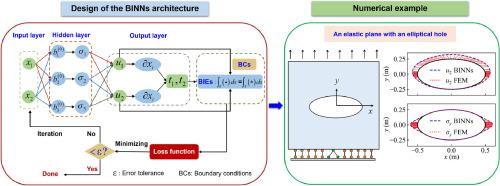当前位置:
X-MOL 学术
›
Int. J. Mech. Sci.
›
论文详情
Our official English website, www.x-mol.net, welcomes your feedback! (Note: you will need to create a separate account there.)
Boundary integrated neural networks for 2D elastostatic and piezoelectric problems
International Journal of Mechanical Sciences ( IF 7.1 ) Pub Date : 2024-07-05 , DOI: 10.1016/j.ijmecsci.2024.109525 Peijun Zhang , Longtao Xie , Yan Gu , Wenzhen Qu , Shengdong Zhao , Chuanzeng Zhang
International Journal of Mechanical Sciences ( IF 7.1 ) Pub Date : 2024-07-05 , DOI: 10.1016/j.ijmecsci.2024.109525 Peijun Zhang , Longtao Xie , Yan Gu , Wenzhen Qu , Shengdong Zhao , Chuanzeng Zhang

|
In this paper, we make the first attempt to adopt the boundary integrated neural networks (BINNs) for the numerical solution of two-dimensional (2D) elastostatic and piezoelectric problems. The proposed BINNs combine the artificial neural networks with the exact boundary integral equations (BIEs) to effectively solve the boundary value problems based on the corresponding partial differential equations (PDEs). The BIEs are utilized to localize all the unknown physical quantities on the boundary, which are approximated by using artificial neural networks and resolved via a training process. In contrast to many traditional neural network methods based on a domain discretization, the present BINNs offer several distinct advantages. Firstly, by embedding the analytical BIEs into the learning procedure, the present BINNs only need to discretize the boundary of the problem domain, which reduces the number of the unknowns and can lead to a faster and more stable learning process. Secondly, the differential operators in the original PDEs are substituted by integral operators, which can effectively eliminate the need for additional differentiations of the neural networks (high-order derivatives of the neural networks may lead to instabilities in the learning process). Thirdly, the loss function of the present BINNs only contains the residuals of the BIEs, as all the boundary conditions have been inherently incorporated within the formulation. Therefore, there is no necessity for employing any weighting functions, which are commonly used in most traditional methods to balance the gradients among the different objective functions. Extensive numerical experiments show that the present BINNs are much easier to train and can usually provide more accurate solutions as compared to many traditional neural network methods.
中文翻译:

用于二维弹性静力学和压电问题的边界集成神经网络
在本文中,我们首次尝试采用边界集成神经网络(BINN)来数值求解二维(2D)弹性静力学和压电问题。所提出的 BINN 将人工神经网络与精确边界积分方程(BIE)相结合,以有效地解决基于相应偏微分方程(PDE)的边值问题。 BIE 用于定位边界上的所有未知物理量,这些物理量通过使用人工神经网络进行近似并通过训练过程进行求解。与许多基于域离散化的传统神经网络方法相比,当前的 BINN 具有几个明显的优势。首先,通过将分析BIE嵌入到学习过程中,目前的BINN只需要离散化问题域的边界,这减少了未知数的数量,并且可以导致更快、更稳定的学习过程。其次,将原始偏微分方程中的微分算子替换为积分算子,可以有效消除神经网络额外微分的需要(神经网络的高阶导数可能会导致学习过程的不稳定)。第三,当前 BINN 的损失函数仅包含 BIE 的残差,因为所有边界条件都已固有地包含在公式中。因此,没有必要采用大多数传统方法中常用的任何加权函数来平衡不同目标函数之间的梯度。 大量的数值实验表明,与许多传统的神经网络方法相比,目前的 BINN 更容易训练,并且通常可以提供更准确的解决方案。
更新日期:2024-07-05
中文翻译:

用于二维弹性静力学和压电问题的边界集成神经网络
在本文中,我们首次尝试采用边界集成神经网络(BINN)来数值求解二维(2D)弹性静力学和压电问题。所提出的 BINN 将人工神经网络与精确边界积分方程(BIE)相结合,以有效地解决基于相应偏微分方程(PDE)的边值问题。 BIE 用于定位边界上的所有未知物理量,这些物理量通过使用人工神经网络进行近似并通过训练过程进行求解。与许多基于域离散化的传统神经网络方法相比,当前的 BINN 具有几个明显的优势。首先,通过将分析BIE嵌入到学习过程中,目前的BINN只需要离散化问题域的边界,这减少了未知数的数量,并且可以导致更快、更稳定的学习过程。其次,将原始偏微分方程中的微分算子替换为积分算子,可以有效消除神经网络额外微分的需要(神经网络的高阶导数可能会导致学习过程的不稳定)。第三,当前 BINN 的损失函数仅包含 BIE 的残差,因为所有边界条件都已固有地包含在公式中。因此,没有必要采用大多数传统方法中常用的任何加权函数来平衡不同目标函数之间的梯度。 大量的数值实验表明,与许多传统的神经网络方法相比,目前的 BINN 更容易训练,并且通常可以提供更准确的解决方案。












































 京公网安备 11010802027423号
京公网安备 11010802027423号